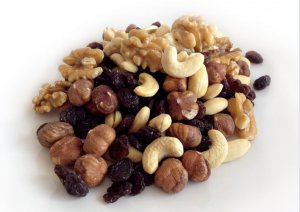Beginner's Guide: Meal Plan

If you are thinking about changing your habits and taking care of your diet, you should know that the best option is to create a meal plan. It’s a useful, quick and practical way to control what you eat during the week and make sure you eat all the nutrients in the right proportions.
We recommend that on Saturday or your free day, you prepare a weekly meal plan following the guidelines that we’ll provide for you below. Then, buy the necessary food to make the weekly menu.
During the week you won’t have to think about meals since you only have to follow the plan and cook the meal that corresponds to each day. As you had previously planned this, you’ll have all the ingredients at home, ready, and you’ll only have to cook.
Meal plan: five fruits and vegetables a day
As you’ve heard many times, nutritionists recommend consuming five fruits and vegetables every day. This may seem too much to you, and you may think it’s difficult to consume this amount? Actually, it’s very simple, it’s enough that in each meal, you include the following foods.

Having five a day doesn’t have to be a difficult task:
- A piece of fruit after meals. It’s a way to enjoy a healthy dessert full of vitamins.
- Have salad at dinner time. It’s satiating and easily digested so it’s suitable to have during the last meal of the day.
- Natural juices for breakfast. Try these recipes and make your own fruit juices and green juices. They contain all the nutrients you need.
- Eat seasonal vegetables. You can eat the vegetables on their own, or mixed with legumes and potatoes, etc. You have so many options!
Consider the time of year
Another aspect that you should consider when preparing your meal plan is the time of the year. This is important for two reasons:
- Cold or hot foods. During the summer, cold foods are more appetizing so you should include recipes for salads, gazpacho or juices in your weekly plan. On the other hand, in winter, hot preparations such as stews or soups are more appealing. Choosing food according to the season will make it easier to follow the weekly plan.
- Seasonal foods. Always choose seasonal food because its quality is much higher, as well as its flavor and freshness and also its price is very economical.
Divide the plate into fractions
If you are a beginner with healthy eating a good trick is to follow the rule of the division of the plate. In this simple way, you’ll create healthy and balanced dishes in each of the meals you make throughout the day. The proportions that you must follow are:
- 50 percent vegetables. The middle of the plate should always be composed of vegetables. They are so varied and can be cooked in so many ways that the options are endless. You can have salads and raw or cooked vegetables. It doesn’t matter what the vegetable is, provided it’s cooked in a healthy way and occupies half of the dish.
- 25 percent proteins. A quarter of the dish should contain this nutrient. Remember, proteins can be of both animal and vegetable origin. In this part of the dish, you would find meat, fish, nuts or legumes.
- 25 percent carbohydrates. Perfect to provide the energy we consume during the day. In this last space of the dish, you would find cereals, pasta or potatoes.

Just imagine the dish as a division of three different spaces. In this simple way and with little effort or knowledge about nutrition you can make healthy, satisfying and balanced dishes.
Remember that these dishes should always be complemented by water and a piece of fruit. In addition, you can have one or two slices of bread with each meal.
Developing a weekly plan is a task that any beginner can perform. Simply follow the guidelines we have given you and plan your weekly menu.
If you are thinking about changing your habits and taking care of your diet, you should know that the best option is to create a meal plan. It’s a useful, quick and practical way to control what you eat during the week and make sure you eat all the nutrients in the right proportions.
We recommend that on Saturday or your free day, you prepare a weekly meal plan following the guidelines that we’ll provide for you below. Then, buy the necessary food to make the weekly menu.
During the week you won’t have to think about meals since you only have to follow the plan and cook the meal that corresponds to each day. As you had previously planned this, you’ll have all the ingredients at home, ready, and you’ll only have to cook.
Meal plan: five fruits and vegetables a day
As you’ve heard many times, nutritionists recommend consuming five fruits and vegetables every day. This may seem too much to you, and you may think it’s difficult to consume this amount? Actually, it’s very simple, it’s enough that in each meal, you include the following foods.

Having five a day doesn’t have to be a difficult task:
- A piece of fruit after meals. It’s a way to enjoy a healthy dessert full of vitamins.
- Have salad at dinner time. It’s satiating and easily digested so it’s suitable to have during the last meal of the day.
- Natural juices for breakfast. Try these recipes and make your own fruit juices and green juices. They contain all the nutrients you need.
- Eat seasonal vegetables. You can eat the vegetables on their own, or mixed with legumes and potatoes, etc. You have so many options!
Consider the time of year
Another aspect that you should consider when preparing your meal plan is the time of the year. This is important for two reasons:
- Cold or hot foods. During the summer, cold foods are more appetizing so you should include recipes for salads, gazpacho or juices in your weekly plan. On the other hand, in winter, hot preparations such as stews or soups are more appealing. Choosing food according to the season will make it easier to follow the weekly plan.
- Seasonal foods. Always choose seasonal food because its quality is much higher, as well as its flavor and freshness and also its price is very economical.
Divide the plate into fractions
If you are a beginner with healthy eating a good trick is to follow the rule of the division of the plate. In this simple way, you’ll create healthy and balanced dishes in each of the meals you make throughout the day. The proportions that you must follow are:
- 50 percent vegetables. The middle of the plate should always be composed of vegetables. They are so varied and can be cooked in so many ways that the options are endless. You can have salads and raw or cooked vegetables. It doesn’t matter what the vegetable is, provided it’s cooked in a healthy way and occupies half of the dish.
- 25 percent proteins. A quarter of the dish should contain this nutrient. Remember, proteins can be of both animal and vegetable origin. In this part of the dish, you would find meat, fish, nuts or legumes.
- 25 percent carbohydrates. Perfect to provide the energy we consume during the day. In this last space of the dish, you would find cereals, pasta or potatoes.

Just imagine the dish as a division of three different spaces. In this simple way and with little effort or knowledge about nutrition you can make healthy, satisfying and balanced dishes.
Remember that these dishes should always be complemented by water and a piece of fruit. In addition, you can have one or two slices of bread with each meal.
Developing a weekly plan is a task that any beginner can perform. Simply follow the guidelines we have given you and plan your weekly menu.
All cited sources were thoroughly reviewed by our team to ensure their quality, reliability, currency, and validity. The bibliography of this article was considered reliable and of academic or scientific accuracy.
Santos, L. A. D. S. (2005). Educação alimentar e nutricional no contexto da promoção de práticas alimentares saudáveis.
de Oliveira, S. I., & Oliveira, K. S. (2008). Novas perspectivas em educação alimentar e nutricional. Psicologia Usp, 19(4), 495-504.
This text is provided for informational purposes only and does not replace consultation with a professional. If in doubt, consult your specialist.








